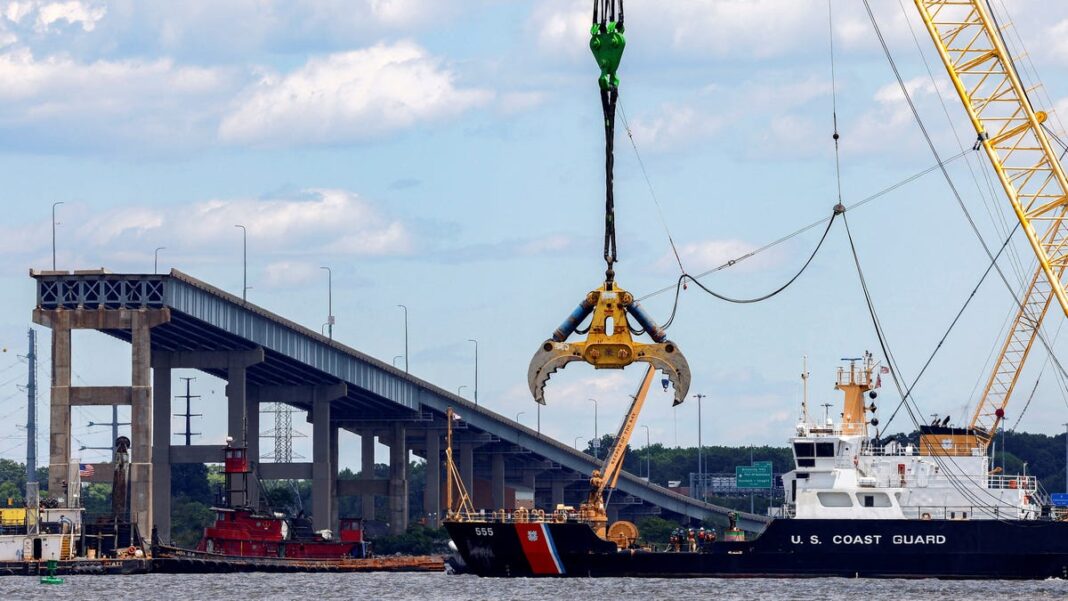Owner of Cargo Ship Linked to Baltimore Bridge Collapse Agrees to Pay $102 Million for Cleanup
This settlement will help cover federal expenses from the incident, such as debris removal to reopen the shipping channel by June.
The company that owns and operates the cargo ship responsible for the tragic collapse of the Francis Scott Key Bridge in Baltimore has agreed to pay $102 million to resolve a lawsuit from the U.S. Department of Justice, settled on Thursday.
In September, the Justice Department initiated a civil lawsuit demanding over $103 million from two Singapore-based companies: Grace Ocean Private Limited and Synergy Marine Private Limited. The agreement will cover the federal expenditures related to the response to the catastrophe, which included removing debris to reopen the Fort McHenry Shipping Channel in June.
“Today’s agreement marks a significant step forward nearly seven months following one of the most devastating transportation accidents in recent history, which resulted in six fatalities and extensive damage,” stated Principal Deputy Associate Attorney General Benjamin Mizer on Thursday. “This resolution guarantees that the costs of the federal government’s cleanup efforts in the Fort McHenry Channel will be shouldered by Grace Ocean and Synergy, sparing the American taxpayer from the burden.”
According to Mizer, the owners of the Dali were “acutely aware” of the ongoing problems with the ship’s electrical and mechanical systems, yet they neglected to take appropriate action, driven by negligence, poor management, and sometimes a desire to save money. Court filings indicated that excessive vibrations on the vessel had harmed its systems, leading to failures in the switchboards and transformers.
More than 50 federal, state, and local agencies collaborated to remove approximately 50,000 tons of steel, concrete, and asphalt from both the channel and the Dali following the March 26 collapse, as reported by the Justice Department. The incident halted operations at the nation’s largest vehicle-handling port, significantly impacting the economy.
Efforts to clear the debris and set up alternative marine traffic routes took nearly three months. The Fort McHenry Shipping Channel was returned to its original operational depth by June 10.
However, the settlement announced on Thursday does not include compensation for rebuilding the Francis Scott Key Bridge, according to the Justice Department. Maryland officials estimate the cost of reconstruction to be between $1.7 billion and $1.9 billion, projected to be completed by 2028.
Additionally, the state has filed a separate lawsuit against the owner and operator of the Dali to recover costs for the bridge, cleanup, environmental impact, and other expenses. Any funds recovered by Maryland will help to minimize the financial burden on the federal government, the Justice Department noted.
What Caused the Francis Scott Key Bridge Incident?
In the early hours of March 26, the Dali set sail from the Port of Baltimore heading to Sri Lanka when it collided with one of the bridge’s support columns, leading to the bridge’s collapse into the water. Footage showed the ship hitting the bridge seemingly after losing power.
At the time, eight construction workers were repairing potholes on the bridge. Two managed to escape, while six tragically lost their lives.
Following the incident, the FBI launched a criminal investigation in April. A preliminary report from the National Transportation Safety Board in May suggested that the Dali had experienced power loss twice before the collision with the bridge.
The lawsuit filed by the Justice Department claimed that the ship was not properly maintained. Authorities indicated the loss of power occurred after the circuit breakers in a transformer tripped.
The Justice Department specified that the transformer and circuit breakers had been negatively affected by severe vibrations over time. The suit further alleged that rather than rectifying the issue causing these vibrations, the crew made temporary fixes to the ship.
The crew had made “makeshift” adjustments to the equipment, including retrofitting the transformer with anti-vibration supports and placing a metal cargo hook between the transformer and a steel beam nearby to reduce vibrations, as indicated in the lawsuit. Federal prosecutors also highlighted that one of the anti-vibration braces had broken, was repaired using welds, and then broke again.
“The DALI’s electrical and mechanical systems were inadequately maintained and configured in violation of safety regulations and standards for international shipping,” the lawsuit asserts. “These deficiencies led to power loss and a sequence of failures that culminated in the collision.”

